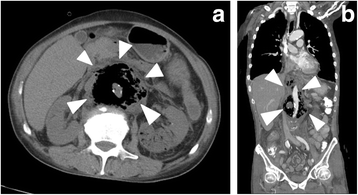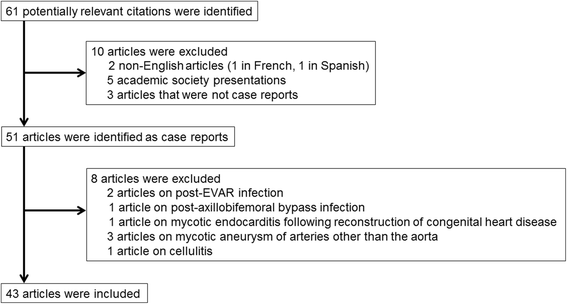Presence of periaortic gas in Clostridium septicum-infected aortic aneurysm aids in early diagnosis: a case report and systematic review of the literature
- PMID: 28931420
- PMCID: PMC5607595
- DOI: 10.1186/s13256-017-1422-0
Presence of periaortic gas in Clostridium septicum-infected aortic aneurysm aids in early diagnosis: a case report and systematic review of the literature
Abstract
Background: Clostridium septicum-infected aortic aneurysm is a fatal and rare disease. We present a fatal case of C. septicum-infected aortic aneurysm and a pertinent literature review with treatment suggestions for reducing mortality rates.
Case presentation: A 58-year-old Japanese man with an unremarkable medical history presented with a 3-day history of mild weakness in both legs, and experienced paraplegia and paresthesia a day before admission. Upon recognition of signs of an abdominal aortic aneurysm and paraplegia, we suspected an occluded Adamkiewicz artery and performed a contrast-enhanced computed tomography scan, which revealed an aortic aneurysm with periaortic gas extending from his chest to his abdomen and both kidneys. Antibiotics were initiated followed by emergency surgery for source control of the infection. However, owing to his poor condition and septic shock, aortic repair was not possible. We performed bilateral nephrectomy as a possible source control, after which we initiated mechanical ventilation, continuous hemodialysis, and hemoperfusion. A culture of the samples taken from the infected region and four consecutive blood cultures yielded C. septicum. His condition gradually improved postoperatively; however, on postoperative day 10, massive hemorrhage due to aortic rupture resulted in his death.
Conclusions: In this patient, C. septicum was thought to have entered his blood through a gastrointestinal tumor, infected the aorta, and spread to his kidneys. However, we were uncertain whether there was an associated malignancy. A literature review of C. septicum-related aneurysms revealed the following: 6-month mortality, 79.5%; periaortic gas present in 92.6% of cases; no standard operative procedure and no guidelines for antimicrobial administration established; and C. septicum was associated with cancer in 82.5% of cases. Thus, we advocate for early diagnosis via the identification of periaortic gas, as an aortic aneurysm progresses rapidly. To reduce the risk of reinfection as well as infection of other sites, there is the need for concurrent surgical management of the aneurysm and any associated malignancy. We recommend debridement of the infectious focus and in situ vascular graft with omental coverage. Postoperatively, orally administered antibiotics must be continued indefinitely (chronic suppression therapy). We believe that these treatments will decrease mortality due to C. septicum-infected aortic aneurysms.
Keywords: Adult; Aortic dissection; Aortic rupture; Clostridium spp; Colon adenocarcinoma; Infected aortic aneurysm; Sepsis; Septic shock.
Conflict of interest statement
Consent for publication
Written informed consent was obtained from the patient’s next of kin for publication of this case report and any accompanying images. A copy of the written consent is available for review by the Editor-in-Chief of this journal.
Competing interests
The authors declare that they have no competing interests.
Publisher’s Note
Springer Nature remains neutral with regard to jurisdictional claims in published maps and institutional affiliations.
Figures


References
-
- de Virgilio C, Klein S, Chang L, et al. Clostridial bacteremia: implications for the surgeon. Am Surg. 1991;57:388–93. - PubMed
Publication types
MeSH terms
LinkOut - more resources
Full Text Sources
Other Literature Sources
Miscellaneous

